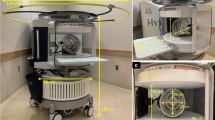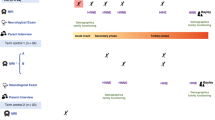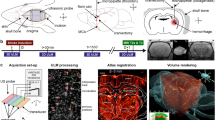Abstract
Using an 11.7-Tesla magnetic resonance imaging (MRI) scanner in 10-d-old rat pups we report on the evolution of injury over 28 d in a model of neonatal stroke (transient filament middle cerebral artery occlusion, tfMCAO) and a model of hypoxic-ischemic injury (Rice-Vannucci model, RVM). In both models, diffusion-weighted imaging (DWI) was more sensitive in the early detection of ischemia than T2-weighted imaging (T2WI). Injury volumes in both models were greater on d 1 for DWI and d 3 for T2WI, decreased over time and by d 28 T2WI injury volumes (tfMCAO 10.3% of ipsilateral hemisphere; RVM 23.9%) were definable. The distribution of injury with tfMCAO was confined to the vascular territory of the middle cerebral artery and a definable core and penumbra evolved over time. Ischemic injury in the RVM was more generalized and greater in cortical regions. Contralateral hemispheric involvement was only observed in the RVM. Our findings demonstrate that high-field MRI over extended periods of time is possible in a small animal model of neonatal brain injury and that the tfMCAO model should be used for studies of neonatal stroke and that the RVM does not reflect the vascular distribution of injury seen with focal ischemia.
Similar content being viewed by others
Log in or create a free account to read this content
Gain free access to this article, as well as selected content from this journal and more on nature.com
or
Abbreviations
- DWI:
-
diffusion-weighted imaging
- FOV:
-
field of view
- MCA:
-
middle cerebral artery
- RVM:
-
Rice-Vannucci model
- tfMCAO:
-
transient middle cerebral artery occlusion
- SHR:
-
spontaneously hypertensive rat
References
Ashwal S, Pearce WJ 2001 Animal models of neonatal stroke. Curr Opin Pediatr 13: 506–516
Yager JY 2004 Animal models of hypoxic-ischemic brain damage in the newborn. Semin Pediatr Neurol 11: 31–46
Ashwal S, Cole DJ, Osborne S, Osborne TN, Pearce WJ 1995 A new model of neonatal stroke: reversible middle cerebral artery occlusion in the rat pup. Pediatr Neurol 12: 191–196
Ashwal S, Obenaus A, Tone B, Tian HR, Chong S 2006 Serial magnetic resonance imaging in a rat pup filament stroke model. Exp Neurol 202: 294–301
Rice JE 3rd, Vannucci RC, Brierley JB 1981 The influence of immaturity on hypoxic-ischemic brain damage in the rat. Ann Neurol 9: 131–141
Neumann-Haefelin T, Kastrup A, de Crespigny A, Yenari MA, Ringer T, Sun GH, Moseley ME 2000 Serial MRI after transient focal cerebral ischemia in rats: dynamics of tissue injury, blood-brain barrier damage, and edema formation. Stroke 31: 1965–1972
Dijkhuizen RM, Knollema S, van der Worp HB, Ter Horst GJ, De Wildt DJ, Berkelbach van der Sprenkel JW, Tulleken KA, Nicolay K 1998 Dynamics of cerebral tissue injury and perfusion after temporary hypoxia-ischemia in the rat: evidence for region-specific sensitivity and delayed damage. Stroke 29: 695–704
Tuor UI, Kozlowski P, Del Bigio MR, Ramjiawan B, Su S, Malisza K, Saunders JK 1998 Diffusion- and T2-weighted increases in magnetic resonance images of immature brain during hypoxia-ischemia: transient reversal posthypoxia. Exp Neurol 150: 321–328
Derugin N, Wendland M, Muramatsu K, Roberts TP, Gregory G, Ferriero DM, Vexler ZS 2000 Evolution of brain injury after transient middle cerebral artery occlusion in neonatal rats. Stroke 31: 1752–1761
Meng S, Qiao M, Foniok T, Tuor UI 2005 White matter damage precedes that in gray matter despite similar magnetic resonance imaging changes following cerebral hypoxia-ischemia in neonatal rats. Exp Brain Res 166: 56–60
Thornton JS, Ordidge RJ, Penrice J, Cady EB, Amess PN, Punwani S, Clemence M, Wyatt JS 1998 Temporal and anatomical variations of brain water apparent diffusion coefficient in perinatal cerebral hypoxic-ischemic injury: relationships to cerebral energy metabolism. Magn Reson Med 39: 920–927
Blumberg RM, Cady EB, Wigglesworth JS, McKenzie JE, Edwards AD 1997 Relation between delayed impairment of cerebral energy metabolism and infarction following transient focal hypoxia-ischemia in the developing brain. Exp Brain Res 113: 130–137
Vannucci RC, Vannucci SJ 2005 Perinatal hypoxic-ischemic brain damage: evolution of an animal model. Dev Neurosci 27: 81–86
Qiao M, Meng S, Scobie K, Foniok T, Tuor UI 2004 Magnetic resonance imaging of differential gray versus white matter injury following a mild or moderate hypoxic-ischemic insult in neonatal rats. Neurosci Lett 368: 332–336
McQuillen PS, Ferriero DM 2004 Selective vulnerability in the developing central nervous system. Pediatr Neurol 30: 227–235
Bardutzky J, Shen Q, Bouley J, Sotak CH, Duong TQ, Fisher M 2005 Perfusion and diffusion imaging in acute focal cerebral ischemia: temporal vs. spatial resolution. Brain Res 1043: 155–162
Manabat C, Han BH, Wendland M, Derugin N, Fox CK, Choi J, Holtzman DM, Ferriero DM, Vexler ZS 2003 Reperfusion differentially induces caspase-3 activation in ischemic core and penumbra after stroke in immature brain. Stroke 34: 207–213
Weinstein PR, Hong S, Sharp FR 2004 Molecular identification of the ischemic penumbra. Stroke 35: 2666–2670
Felszeghy K, Banisadr G, Rostene W, Nyakas C, Haour FN 2004 Dexamethasone down regulates chemokine receptor CXCR4 and exerts neuroprotection against hypoxia/ischemia-induced brain injury in neonatal rats. Neuroimmunomodulation 11: 404–413
Towfighi J, Zec N, Yager J, Housman C, Vannucci RC 1995 Temporal evolution of neuropathologic changes in an immature rat model of cerebral hypoxia: a light microscopic study. Acta Neuropathol (Berl) 90: 375–386
Towfighi J, Mauger D, Vannucci RC, Vannucci SJ 1997 Influence of age on the cerebral lesions in an immature rat model of cerebral hypoxia-ischemia: a light microscopic study. Brain Res Dev Brain Res 100: 149–160
Acknowledgements
The authors thank Dr. Yata Kenichiro and Dr. John Zhang for their assistance in the RVM experiments and Drs. David Michelson and Brenda Bartnik for their review of the manuscript.
Author information
Authors and Affiliations
Corresponding author
Additional information
Supported by the Pediatric Research Fund, Department of Pediatrics, Loma Linda University School of Medicine, grant number OSR# 83018.
Rights and permissions
About this article
Cite this article
Ashwal, S., Tone, B., Tian, H. et al. Comparison of Two Neonatal Ischemic Injury Models Using Magnetic Resonance Imaging. Pediatr Res 61, 9–14 (2007). https://doi.org/10.1203/01.pdr.0000251612.16069.4b
Received:
Accepted:
Issue date:
DOI: https://doi.org/10.1203/01.pdr.0000251612.16069.4b
This article is cited by
-
Systemic administration of clinical-grade multilineage-differentiating stress-enduring cells ameliorates hypoxic–ischemic brain injury in neonatal rats
Scientific Reports (2023)
-
COX5A over-expression protects cortical neurons from hypoxic ischemic injury in neonatal rats associated with TPI up-regulation
BMC Neuroscience (2020)
-
The Dynamics of Impaired Blood-Brain Barrier Restoration in a Rat Model of Co-morbid Injury
Molecular Neurobiology (2018)
-
Mechanisms of Perinatal Arterial Ischemic Stroke
Journal of Cerebral Blood Flow & Metabolism (2014)
-
Deficits of brainstem and spinal cord functions after neonatal hypoxia–ischemia in mice
Pediatric Research (2014)



